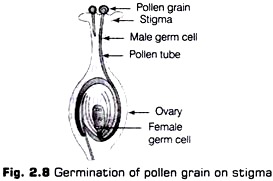ADVERTISEMENTS:
The below mentioned article provides a note on pollen-pistil interaction.
It is an essential step of fertilisation of angiosperms. It determines compatibility and incompatibility. This interaction have been studied at a molecular and cellular level in relatively few families.
It is a dynamic process involving pollen recognition followed by inhibition or promotion of pollen.
ADVERTISEMENTS:
The events from the deposition of pollen on the stigma till the pollen tube enters the ovule are collecting called pollen-pistil interaction.
This includes:
Recognition of Compatible Pollen:
The pistil has the ability to recognise the right compatible pollen of the same species and to reject the pollen grains that are incompatible either of same species or of other species. After recognition of correct pollen pistil promotes post-pollen events that leads to fertilisation.
ADVERTISEMENTS:
Fusion of the male gamete with the female gamete to form a diploid zygote within the embryo sac is called fertilisation. In angiosperms, the male gametes are carried to the egg by the pollen tube, termed as siphonogamy.
Growth of a Pollen Tube:
The contents of the pollen then move into this tube i.e., the tube nucleus (nucleus of vegetative cell) and the generative cell. The pollen tube grows through the tissues of stigma and style by secreting. The enzymes to digest them. The 2-celled pollen grains reach the receptive stigma of the carpel by the act of pollination. Pollen grains after getting attached to the stigma absorb water and swell.
Entry of Pollen Tube into the Ovule:
After reaching the ovary, the pollen tube enters the ovule through micropylar end. It then enters one of the synergids through the filiform apparatus present at micropylar end. The synergids direct the growth of pollen tube by secreting some chemical substances.
The tip of the pollen tube enters one synergid, then the penetrated synergid starts degenerating. After penetration, the tip of the pollen tube enlarges and ruptures by releasing the contents, including the two male gametes and vegetative nucleus.

